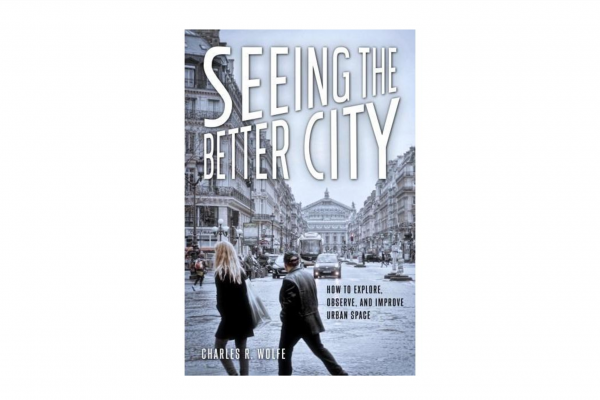
Author: Charles R. Wolfe (Island Press, 2017)
In many cities, the process of planning and designing our communities has become separated from the experience of living in them. Increasingly, abstract tools like big data, digital mapping, and simulated renderings are used to make decisions affecting the future of our neighbourhoods. While these tools can be helpful to understand urban spaces, they can easily overlook the authentic human experiences that are essential for creating truly livable cities.
In Seeing the Better City, urbanist writer, photographer, and land use attorney, Charles R. (Chuck) Wolfe has outlined a comprehensive toolkit for helping to reintroduce the human experience into urban planning. He believes that public dialogue about the future of our cities will be more productive if residents are actively engaged in documenting and thinking about what is actually happening. According to Wolfe, personal perspectives are key ingredients in understanding the dynamics of urban space and creating better, and more equitable, plans, policies, and political decisions. He calls this the “urban diary” approach, that is summarized in a handy acronym: LENS—looking, exploring, narrating, and summarizing.
Personalizing Our Cities
Urban diaries create descriptive portraits of how we are experiencing our evolving cities. With the right perspective, residents can help shape their communities by the simple acts of observing and documenting what they see around them. These ‘portraits’ can then be shared with neighbours (and decision makers) and used for constructive dialogue and engagement about the future of our urban form.
A quick look at social media sites like Facebook and Instagram show that many people are already on the way to creating urban diaries, even if they don’t realize it. Seeing the Better City provides a toolkit on how to build on the act of taking and sharing images of our daily travels: organizing them in a way to create a personalized narrative about our cities.
Wolfe emphasizes how the personal perspective of the observer—including our cultural identities and past experiences—are key to understanding the dynamics of urban space. It is this process of taking and thinking through our OWN photos that is important, since it can’t be duplicated by looking at images taken by others, reviewing artistic renderings or reading studies and reports.
From Diaries to Decisions
The values of a urban diary goes beyond simply improving our own understanding and discussions about the evolution of cities. Wolfe argues we need more policy based on experience and observation, and that the incorporation of residents’ photographs into the civic decision-making process could greatly improve the decision-making process. He believes that thoughtful observations of the sights, sounds, and experiences of our cities can play an important role in informing the policies, plans, and politics that shape our neighbourhood dynamics, transportation systems, and a variety of other urban elements that affect our daily lives.
Seeing the Better City uses modern technologies to refresh the historical, interdisciplinary tradition of urban observation. The contemporary “urban diary” outlined in this book provides a step-by-step guide to encourage readers to explore and document the urban spaces, structures and human activities around them. In doing so, we can reintroduce human observation to our civic discourse and inspire a more constructive, creative discussion about improving our urban spaces.
***
For more information on Seeing the Better City, How to Explore, Observe, and Improve Urban Space visit the publisher’s website.
**
Yuri Artibise is an experienced community and digital engagement specialist with a passion for urban planning, public participation and social media. He is the Executive Director of the Vancouver City Planning Commission, and is the principal at Yurbanism, a strategic communications and urban engagement consulting practice.



One comment
Have a look at a copy of this book at the Toronto Reference Library, 789 Yonge St., 2nd floor:
http://www.torontopubliclibrary.ca/detail.jsp?Entt=RDM3478274&R=3478274